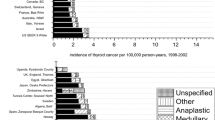Abstract
Background: The objective of this study was to define the epidemiology of thyroid cancer in our regional population and compare results with Surveillance, Epidemiology, and End Results (SEER) Program cancer registry trends.
Methods: Thyroid cancer cases diagnosed between 1990 and 2000 were identified in the Florida Cancer Data System (FCDS). Overall, gender-specific, age-specific, and stage-specific incidence rates were calculated. All rates are per 100,000 and age-adjusted to the 2000 U.S. standard population. Estimated Annual Percent Change (EAPC) was calculated with a linear least-squares model.
Results: Patients with thyroid cancer (n = 8603) were identified in the FCDS registry. Age-adjusted incidence rates increased from 4.2 per 100,000 to 7 per 100,000 in 2000. The EAPC for this period was 5.5% (P < .001). The SEER incidence rates increased from 7.9 to 10.2 per 100,000, and the EAPC was 3.7% (P < .05). Analysis of gender-specific incidence rates showed increases from 6 and 2.2 per 100,000 in 1990 to 10.1 and 3.8 per 100,000 in 2000 among females and males, respectively, with EAPCs of 5.9% (females) and 4.5% (males) (P < .001). With stratification by age group, the highest incidence rates were 9 per 100,000 in the group aged 65 to 84 years and 8.4 per 100,000 in the group aged 45 to 64 years.
Conclusions: Thyroid cancer incidence rates in Florida almost doubled over the 1990–2000 period and are concordant with SEER trends. Etiologic studies addressing temporal changes in reproductive factors, more intensive diagnostic activities, and changes in histological criteria are warranted.
Similar content being viewed by others
REFERENCES
Zheng T, Holford TR, Chen Y, Ma JZ, Flannery J, Liu W. Time trend and age period cohort effect on incidence of thyroid cancer in Connecticut 1935–1992. Int J Cancer 1996; 67:504–9.
Fahy TJ, Reeve TS, Delbridge L. Increasing incidence and changing presentation of thyroid cancer over a 30-year period. Br J Surg 1995; 82:518–20.
Liu S, Seminenciw R, Ugnat AM, Mao Y. Increasing thyroid cancer incidence in Canada, 1970–1996: time trends and age-period-cohort effects. Br J Cancer 2001; 85(9):1335–9.
Levi F, Franceschi S, Gulie C, Negri E, La Vechhia C. Female thyroid cancer: the role of reproductive and hormonal factors in Switzerland. Oncology 1993; 50:309–15.
Pettersson B, Adami HO, Wilander E, Coleman MD. Trends in thyroid cancer incidence in Sweden, 1958–1981, by histopathologic type. Int J Cancer 1991; 48:28–33.
National Cancer Institute. Surveillance, Epidemiology and End Results Program. Available at http://www.seer.cancer.gov.
Fritz A, Percy C, Jack A, et al. International Classification of Diseases for Oncology. Geneva: World Health Organization, 2000.
Kleinbaum DG, Kupper LL, Muller KE. Applied Regression Analysis and Other Multivariate Methods. 2nd ed. Boston: PWS Kent Publishing, 1988:497–512.
Seer Stat 5.1.14. Available at http://www.seer.cancer.gov/seerstat/.
Okayasu I, Fujiwara M, Hara Y, Tanaka Y, Rode NR. Association of chronic lymphocytic thyroiditis and thyroid papillary carcinoma. A study of surgical cases among Japanese, and white, and African Americans. Cancer 1995; 76:2312–8.
Verkooijen H, Fioretta G, Pache JC, et al. Diagnostic changes as a reason for the increase in papillary thyroid cancer in Geneva, Switzerland. Cancer Causes Control 2003; 14:13–7.
Passler C, Prager G, Scheuba C, et al. Follicular variant of papillary thyroid carcinoma: a long-term follow-up. Arch Surg 2003; 138(12):1362–6.
Hedinger C, Williams ED, Sobin LH. The WHO histological classification of thyroid tumors: a commentary on the second edition. Cancer 1989; 63(5):908–11.
Franc B, de la Salmoniere P, Lange F, et al. Interobserver and intraobserver variability in the histopathology of follicular thyroid carcinoma. Hum Pathol 2003; 34:1092–100.
Negri E, Maso LD, Ron E, Vecchia CL, Mark SD, Preston-Martin S. A pooled analysis of case-control studies of thyroid cancer. II. Menstrual and reproductive factors. Cancer Causes Control 1999; 10:143–55.
National Center for Chronic Disease Prevention and Health Promotion. Available at http://www.cdc.gov55.
Del Maso L, La Vecchia C, Franceschi S, et al. A pooled analysis of thyroid cancer studies. V. Anthropometric factors. Cancer Causes Control 2000; 11:137–44.
Leenhardt L, Bernier MO, Boin-Pineau MH, et al. Advances in diagnostic practices affect thyroid cancer incidence in France. Eur J Endocrinol 2004; 150(2):133–9.
North American Association Of Central Cancer Registries. Available at http://www.naaccr.org.
Author information
Authors and Affiliations
Corresponding author
Rights and permissions
About this article
Cite this article
Hodgson, N.C., Button, J. & Solorzano, C.C. Thyroid Cancer: Is the Incidence Still Increasing?. Ann Surg Oncol 11, 1093–1097 (2004). https://doi.org/10.1245/ASO.2004.03.066
Received:
Accepted:
Issue Date:
DOI: https://doi.org/10.1245/ASO.2004.03.066




